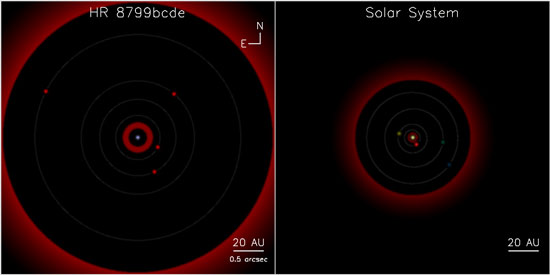| Mar 14, 2013 |
Distant planetary system Is a super-sized solar system
|
|
(Nanowerk News) A team of astronomers, including Quinn Konopacky of the Dunlap Institute for Astronomy & Astrophysics, University of Toronto, has made the most detailed examination yet of the atmosphere of a Jupiter-like planet beyond our Solar System.
|
|
According to Konopacky, “We have been able to observe this planet in unprecedented detail because of the advanced instrumentation we are using on the Keck II telescope, our ground-breaking observing and data-processing techniques, and because of the nature of the planetary system.”
|
|
Konopacky is lead author of the paper describing the team’s findings, to be published March 14th in Science Express, and March 22nd in the journal Science ("Detection of Carbon Monoxide and Water Absorption Lines in an Exoplanet Atmosphere").
|
 |
| Side-by-side comparison showing that the HR8799 system is like a scaled-up, super-sized version of the Solar System.
|
|
The team, using a high-resolution imaging spectrograph called OSIRIS, uncovered the chemical fingerprints of specific molecules, revealing a cloudy atmosphere containing carbon monoxide and water vapour. “With this level of detail,” says Travis Barman, a Lowell Observatory astronomer and co-author of the paper, “we can compare the amount of carbon to the amount of oxygen present in the planet’s atmosphere, and this chemical mix provides clues as to how the entire planetary system formed.”
|
|
There has been considerable uncertainty about how systems of planets form, with two leading models, called core accretion and gravitational instability. Planetary properties, such as the composition of a planet’s atmosphere, are clues as to whether a system formed according to one model or the other.
|
|
“This is the sharpest spectrum ever obtained of an extrasolar planet,” according to co-author Bruce Macintosh of the Lawrence Livermore National Laboratory. “This shows the power of directly imaging a planetary system. It is the exquisite resolution afforded by these new observations that has allowed us to really begin to probe planet formation.”
|
|
The spectrum reveals that the carbon to oxygen ratio is consistent with the core accretion scenario, the model thought to explain the formation of our Solar System.
|
|
The planet, designated HR 8799c, is one of four gas giants known to orbit a star 130 light-years from Earth. The authors and their collaborators previously discovered HR 8799c and its three companions back in 2008 and 2010. All the planets are larger than any in our Solar System, with masses three to seven times that of Jupiter. Their orbits are similarly large when compared to our system. HR 8799c orbits 40 times farther from its parent star than the Earth orbits from the Sun; in our Solar System, that would put it well beyond the realm of Neptune.
|
|
According to the core accretion model, the star HR 8799 was originally surrounded by nothing but a huge disk of gas and dust. As the gas cooled, ice formed; this process depleted the disk of oxygen atoms. Ice and dust collected into planetary cores which, once they were large enough, attracted surrounding gas to form large atmospheres. The gas was depleted of oxygen, and this is reflected in the planet’s atmosphere today as an enhanced carbon to oxygen ratio.
|
|
The core accretion model also predicts that large gas giant planets form at great distances from the central star, and smaller rocky planets closer in, as in our Solar System. It is rocky planets, not too far, nor close to the star, that are prime candidates for supporting life.
|
|
“The results suggest the HR 8799 system is like a scaled-up Solar System,” says Konopacky. “And so, in addition to the gas giants far from their parent star, it would not come as a surprise to find Earth-like planets closer in.”
|
|
The observations of HR 8799c were made with the Keck II 10-metre telescope in Hawaii, one of the two largest optical telescopes in the world. The telescope’s adaptive optics system corrects for distortion caused by the Earth’s atmosphere, making the view through Keck II sharper than through the Hubble Space Telescope.
|
|
Astronomers refer to this as spatial resolution. Seeing exoplanets around stars is like trying to see a firefly next to a spotlight. Keck’s adaptive optics and high spatial resolution, combined with advanced data-processing techniques, allow astronomers to more clearly see both the stellar “spotlight” and planetary “firefly.”
|
|
“We can directly image the planets around HR 8799 because they are all large, young, and very far from their parent star. This makes the system an excellent laboratory for studying exoplanet atmospheres,” says coauthor Christian Marois of the National Research Council of Canada. “Since its discovery, this system just keeps surprising us.”
|
|
Konopacky and her team will continue to study the super-sized planets to learn more details about their nature and their atmospheres. Future observations will be made using the recently upgraded OSIRIS instrument which utilizes a new diffraction grating—the key component of the spectrograph that separates light according to wavelength, just like a prism. The new grating was developed at the Dunlap Institute and installed in the spectrograph in December 2012.
|
|
“These future observations will tell us much more about the planets in this system,” says Dunlap Fellow Konopacky. “And the more we learn about this distant planetary system, the more we learn about our own.”
|

